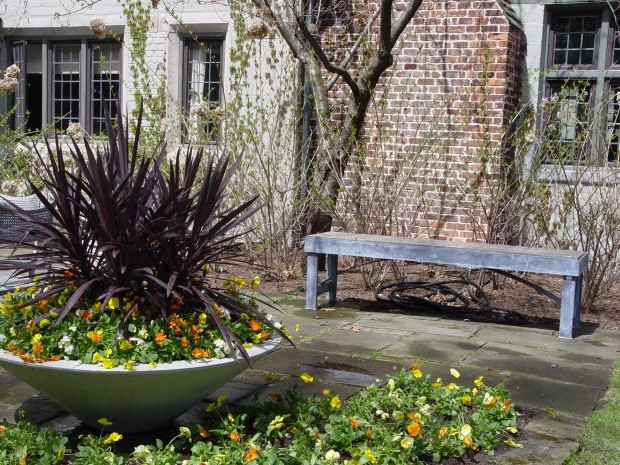 I plant lots of seasonal containers for clients every year. This season has been particularly intense and compressed. Cold nights plagued our area until the very end of May. The week before Memorial Day, we had nights in the 30’s. I was wringing my hands at the prospect of getting out to plant so late, but I have always been stubborn about delaying the planting until we have three nights of 50 degrees or better in a row. It was beginning to feel like that day would never come. This year was a test that kept me awake at night. Even if the weather turns warmer by mid May, there is a terrific lot of work to do, in a short amount of time. So what does a compressed season have to do with the 6″ buckets of spikes pictured above? Rarely does the schedule of the planting of the summer containers permit leisurely planning. The weather turns. I have a lot of work to do. There are certain plants that look good to me, and others that do not interest me much. My design and plant choices boil down to instinct, experience, and whatever else captures my fancy. I have no choice but to trust my eye and my hand, and proceed without over thinking my decisions. As for spikes, I have no history of ever planting them in containers. This year I have planted a lot of them. Spikes. Yes, I have a little spike fest going on.
I plant lots of seasonal containers for clients every year. This season has been particularly intense and compressed. Cold nights plagued our area until the very end of May. The week before Memorial Day, we had nights in the 30’s. I was wringing my hands at the prospect of getting out to plant so late, but I have always been stubborn about delaying the planting until we have three nights of 50 degrees or better in a row. It was beginning to feel like that day would never come. This year was a test that kept me awake at night. Even if the weather turns warmer by mid May, there is a terrific lot of work to do, in a short amount of time. So what does a compressed season have to do with the 6″ buckets of spikes pictured above? Rarely does the schedule of the planting of the summer containers permit leisurely planning. The weather turns. I have a lot of work to do. There are certain plants that look good to me, and others that do not interest me much. My design and plant choices boil down to instinct, experience, and whatever else captures my fancy. I have no choice but to trust my eye and my hand, and proceed without over thinking my decisions. As for spikes, I have no history of ever planting them in containers. This year I have planted a lot of them. Spikes. Yes, I have a little spike fest going on.
 Who knows why I was suddenly so enamored of spikes. Maybe it is a result of having turned 65 a week ago. A murmuring dialogue about my age, and what that might mean may be influencing my choices. Maybe I was feeling old fashioned and out dated. Most years, I am compelled by a need, on some level, to explore. Exploring is generally a good thing. Though the fact that I was planting spikes in containers left and right alarmed me, I did not have the luxury of the time it would take to second guess the impulse. I rolled my eyes, and kept on planting them. Every gardener knows what spikes are. Their grandmother’s routine and pat pots of geraniums at the front door all has a spike in the middle. A pot full of geraniums with a spike in the middle-an icon of container planting from 50 years ago. Even the grandsons of the grandmothers who planted those spikes vaguely remember them, though they may not be able to identify any other seasonal plant. Today’s container plantings are endowed with an incredible variety of plants unknown and unavailable in 1950. Seasonal container design is a very exciting part of gardening right now. Every interested gardener has a generous palette of plants available, and a design atmosphere that is genuinely challenging and interesting.
Who knows why I was suddenly so enamored of spikes. Maybe it is a result of having turned 65 a week ago. A murmuring dialogue about my age, and what that might mean may be influencing my choices. Maybe I was feeling old fashioned and out dated. Most years, I am compelled by a need, on some level, to explore. Exploring is generally a good thing. Though the fact that I was planting spikes in containers left and right alarmed me, I did not have the luxury of the time it would take to second guess the impulse. I rolled my eyes, and kept on planting them. Every gardener knows what spikes are. Their grandmother’s routine and pat pots of geraniums at the front door all has a spike in the middle. A pot full of geraniums with a spike in the middle-an icon of container planting from 50 years ago. Even the grandsons of the grandmothers who planted those spikes vaguely remember them, though they may not be able to identify any other seasonal plant. Today’s container plantings are endowed with an incredible variety of plants unknown and unavailable in 1950. Seasonal container design is a very exciting part of gardening right now. Every interested gardener has a generous palette of plants available, and a design atmosphere that is genuinely challenging and interesting.
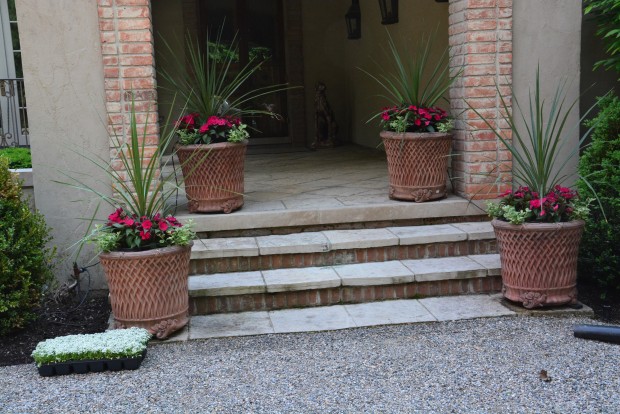 A spike, Dracaena indivisa, is a tropical green plant. It is easy to grow, and tolerates lots of different soil conditions. It likes regular water and sun, but will live amiably with less of everything that it wants. It can be moved inside over the winter, with a minimum of fuss. The timidly broad sword shaped leaves emanate from a central trunk. The leaves are lax, like a grass. They are the anti-centerpiece. They have no extraordinary color or texture. They are just about the last in line of the so called architectural plants available to plant in containers. They are plain green, as in invisibly green. Worse than that, they are very much out of fashion.
A spike, Dracaena indivisa, is a tropical green plant. It is easy to grow, and tolerates lots of different soil conditions. It likes regular water and sun, but will live amiably with less of everything that it wants. It can be moved inside over the winter, with a minimum of fuss. The timidly broad sword shaped leaves emanate from a central trunk. The leaves are lax, like a grass. They are the anti-centerpiece. They have no extraordinary color or texture. They are just about the last in line of the so called architectural plants available to plant in containers. They are plain green, as in invisibly green. Worse than that, they are very much out of fashion.
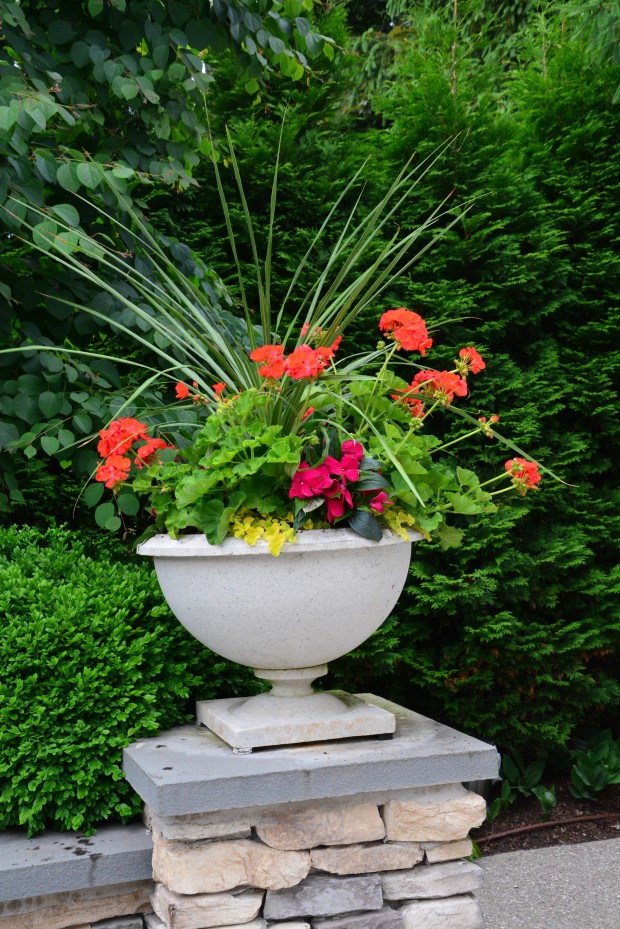 So what is it that I am liking about them? Giving up the notion that the center plant in a pot has to be the most important plant is key. I like how a spike gently and unobtrusively softens the appearance of all of these surrounding plants. The geraniums and New Guineas in this urn are stiff, unyielding, and visually demanding. The spike tones down all that bossy color and form.
So what is it that I am liking about them? Giving up the notion that the center plant in a pot has to be the most important plant is key. I like how a spike gently and unobtrusively softens the appearance of all of these surrounding plants. The geraniums and New Guineas in this urn are stiff, unyielding, and visually demanding. The spike tones down all that bossy color and form.
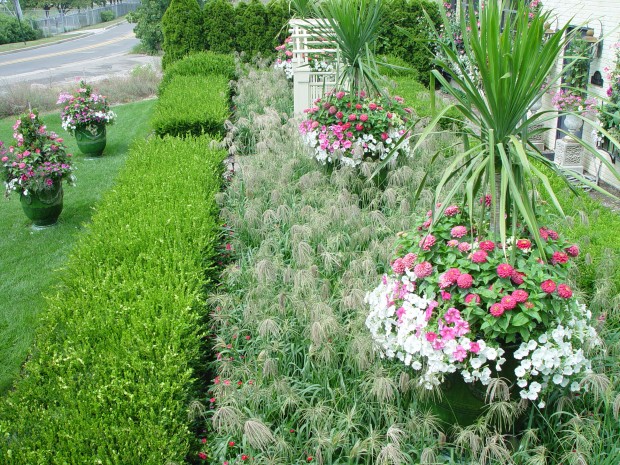 Spikes are simple to winter over in the house. Simple does not mean it is simple minded to plant them. I had this pair of spikes a number of years. Grown on to a large size, they have a much more architectural appearance. In this garden, they provided a little fireworks.
Spikes are simple to winter over in the house. Simple does not mean it is simple minded to plant them. I had this pair of spikes a number of years. Grown on to a large size, they have a much more architectural appearance. In this garden, they provided a little fireworks.
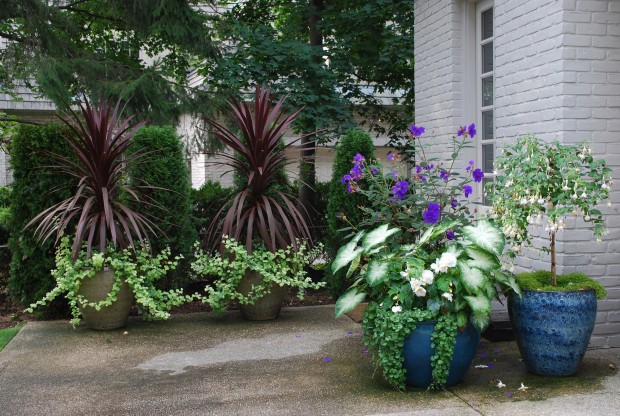 These old red cordylines were grown on from a 6 inch pot. Every year for 8 years now, the arrangement of the pots have changed based on the size of the plants.
These old red cordylines were grown on from a 6 inch pot. Every year for 8 years now, the arrangement of the pots have changed based on the size of the plants.
 Phormiums, commonly known as New Zealand flax, resemble spikes and cordyline in their habit, although the leaves are wider. Some phormiums are quite stiff leaved. Others are droopy. There are lots of cultivars available, in different colors and patterns. Phormiums will rot at the base, if they are planted too low in the container. Outside of that, they are as easy to grow as a spike.
Phormiums, commonly known as New Zealand flax, resemble spikes and cordyline in their habit, although the leaves are wider. Some phormiums are quite stiff leaved. Others are droopy. There are lots of cultivars available, in different colors and patterns. Phormiums will rot at the base, if they are planted too low in the container. Outside of that, they are as easy to grow as a spike.
 The color of this phormium picks up the predominate tones in this group of containers. That peachy pink is especially beautiful with the color of the terra cotta pots.
The color of this phormium picks up the predominate tones in this group of containers. That peachy pink is especially beautiful with the color of the terra cotta pots.
 This planting in this pool side pot is simple, but very strong visually. The phormium “Margaret Jones”, a group of vista fuchsia petunias, and some vinca maculatum work well together, and look nothing like the pots my grandmother planted.
This planting in this pool side pot is simple, but very strong visually. The phormium “Margaret Jones”, a group of vista fuchsia petunias, and some vinca maculatum work well together, and look nothing like the pots my grandmother planted.
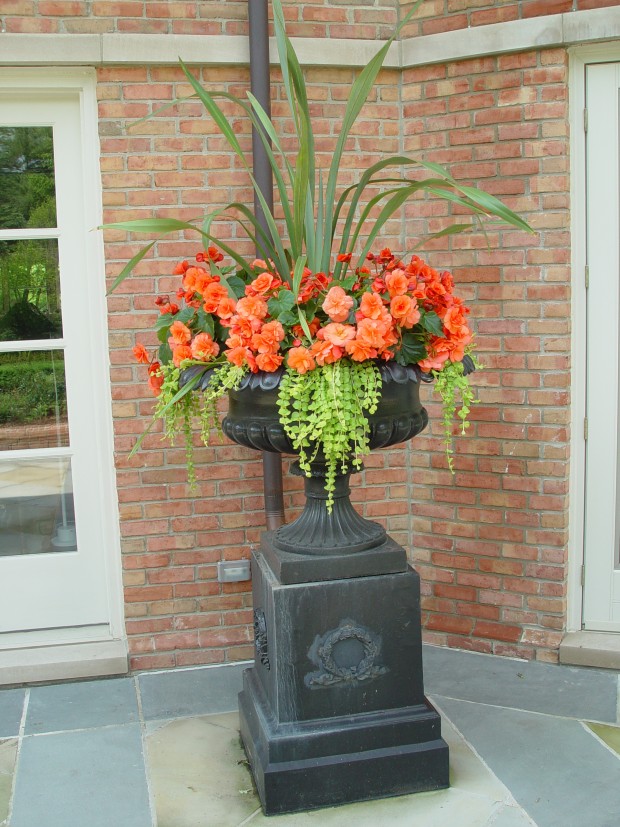 This green phormium is a lovely complement to the solenia begonias. Though it is centrally located in the composition, the visual focus is on the flowers.
This green phormium is a lovely complement to the solenia begonias. Though it is centrally located in the composition, the visual focus is on the flowers.
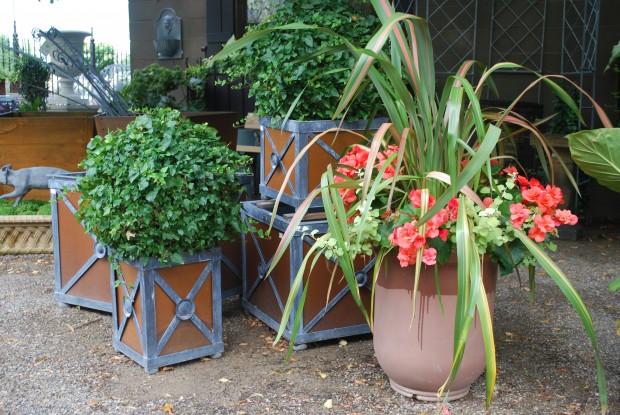 The phormium in this pot takes a much more active role in the overall feeling of this container. Informal and whimsical. The phormium is the plant equivalent of a casual and slightly messy hair do.
The phormium in this pot takes a much more active role in the overall feeling of this container. Informal and whimsical. The phormium is the plant equivalent of a casual and slightly messy hair do.
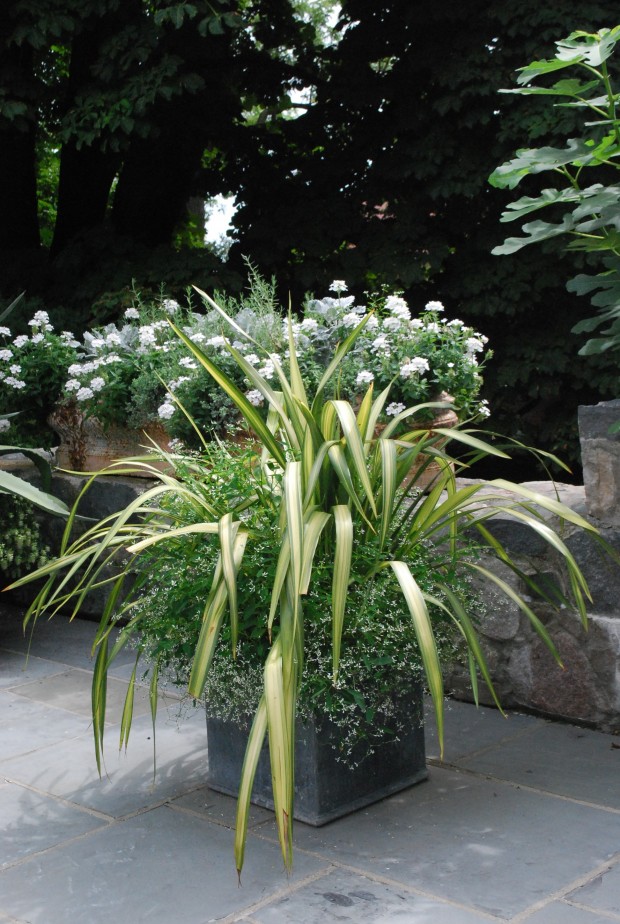 Phormium “Cream Delight” is hard to find, but it makes a beautiful statement in a container. The euphorbia diamond frost goes a long way towards softening that spiky appearance, and adds substance, not bulk.
Phormium “Cream Delight” is hard to find, but it makes a beautiful statement in a container. The euphorbia diamond frost goes a long way towards softening that spiky appearance, and adds substance, not bulk.
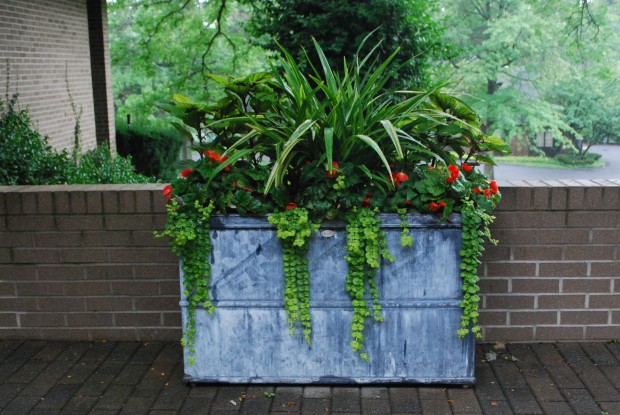 Last, but certainly not least, Dianella is related to phormiums, and similar in most ways except for overall size. They are great for smaller containers. I love how the leaves hover over the rest of the plants in this box. An added plus-dianella blooms.
Last, but certainly not least, Dianella is related to phormiums, and similar in most ways except for overall size. They are great for smaller containers. I love how the leaves hover over the rest of the plants in this box. An added plus-dianella blooms.
 I found a great selection of variegated cordylines at Tellys at Goldner Walsh yesterday. I have not decided what to put with this cultivar,”Torbay Dazzler”, but “Skies of Italy” fancy leaved geraniums might be lovely. This would be a spike and geranium combination that is both fresh and lively.
I found a great selection of variegated cordylines at Tellys at Goldner Walsh yesterday. I have not decided what to put with this cultivar,”Torbay Dazzler”, but “Skies of Italy” fancy leaved geraniums might be lovely. This would be a spike and geranium combination that is both fresh and lively.
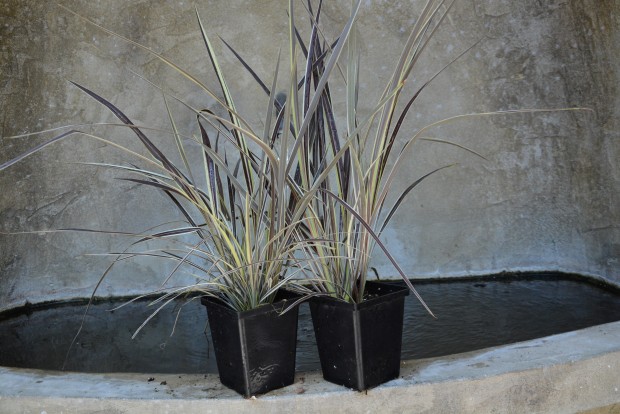 Cordyline “Electric Flash” is brown leaved with limey green stripes. Imagine the possibilities-all from a consideration of the spike.
Cordyline “Electric Flash” is brown leaved with limey green stripes. Imagine the possibilities-all from a consideration of the spike.
